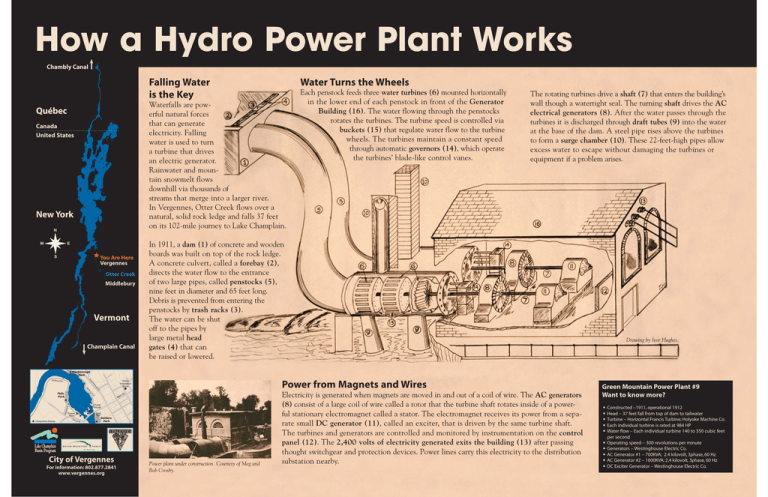How a Hydro Plant Works.indd
advertisement

How a Hydro Power Plant Works Chambly Canal Falling Water is the Key Waterfalls are powerful natural forces that can generate electricity. Falling water is used to turn a turbine that drives an electric generator. Rainwater and mountain snowmelt flows downhill via thousands of streams that merge into a larger river. In Vergennes, Otter Creek flows over a natural, solid rock ledge and falls 37 feet on its 102-mile journey to Lake Champlain. Québec Canada United States New York . % 7 3 You Are Here Vergennes Otter Creek Middlebury Vermont Champlain Canal M 7ALKING4RAIL D ac St IL RA G4 IN in Grist Mill Power Plant Can a l St City of Vergennes For information: 802.877.2841 www.vergennes.org The rotating turbines drive a shaft (7) that enters the building’s wall though a watertight seal. The turning shaft drives the AC electrical generators (8). After the water passes through the turbines it is discharged through draft tubes (9) into the water at the base of the dam. A steel pipe rises above the turbines to form a surge chamber (10). These 22-feet-high pipes allow excess water to escape without damaging the turbines or equipment if a problem arises. Power from Magnets and Wires St Pump House hanic Mec Visitor Information Booth Ma Each penstock feeds three water turbines (6) mounted horizontally in the lower end of each penstock in front of the Generator Building (16). The water flowing through the penstocks rotates the turbines. The turbine speed is controlled via buckets (15) that regulate water flow to the turbine wheels. The turbines maintain a constant speed through automatic governors (14), which operate the turbines’ blade-like control vanes. In 1911, a dam (1) of concrete and wooden boards was built on top of the rock ledge. A concrete culvert, called a forebay (2), directs the water flow to the entrance of two large pipes, called penstocks (5), nine feet in diameter and 65 feet long. Debris is prevented from entering the penstocks by trash racks (3). The water can be shut off to the pipes by large metal head gates (4) that can be raised or lowered. Dr ALK 7 gh ou on Interpretive Display Water Turns the Wheels Power plant under construction. Courtesy of Meg and Bob Crosby. Electricity is generated when magnets are moved in and out of a coil of wire. The AC generators (8) consist of a large coil of wire called a rotor that the turbine shaft rotates inside of a powerful stationary electromagnet called a stator. The electromagnet receives its power from a separate small DC generator (11), called an exciter, that is driven by the same turbine shaft. The turbines and generators are controlled and monitored by instrumentation on the control panel (12). The 2,400 volts of electricity generated exits the building (13) after passing thought switchgear and protection devices. Power lines carry this electricity to the distribution substation nearby. Drawing by Ivor Hughes. Green Mountain Power Plant #9 Want to know more? • • • • • • • • • • Constructed –1911, operational 1912 Head – 37 feet fall from top of dam to tailwater Turbine – Horizontal Francis Turbine; Holyoke Machine Co. Each individual turbine is rated at 984 HP Water flow – Each individual turbine 140 to 350 cubic feet per second Operating speed – 300 revolutions per minute Generators – Westinghouse Electric Co. AC Generator #1 – 700KVA; 2.4 kilovolt, 3phase, 60 Hz AC Generator #2 – 1000KVA; 2.4 kilovolt, 3phase, 60 Hz DC Exciter Generator – Westinghouse Electric Co.




